Innovation and Business Development
VerifiedAdded on 2023/06/12
|9
|2036
|445
AI Summary
The essay provides a detailed analysis of the business models that are currently used in the businesses today. This essay focuses on the issue of less durability of business model compared to the technical advances adopted in Common Wealth Bank in Australia. The sources of the stated issue clarifies that businesses models are developed to create and capture economic value.
Contribute Materials
Your contribution can guide someone’s learning journey. Share your
documents today.
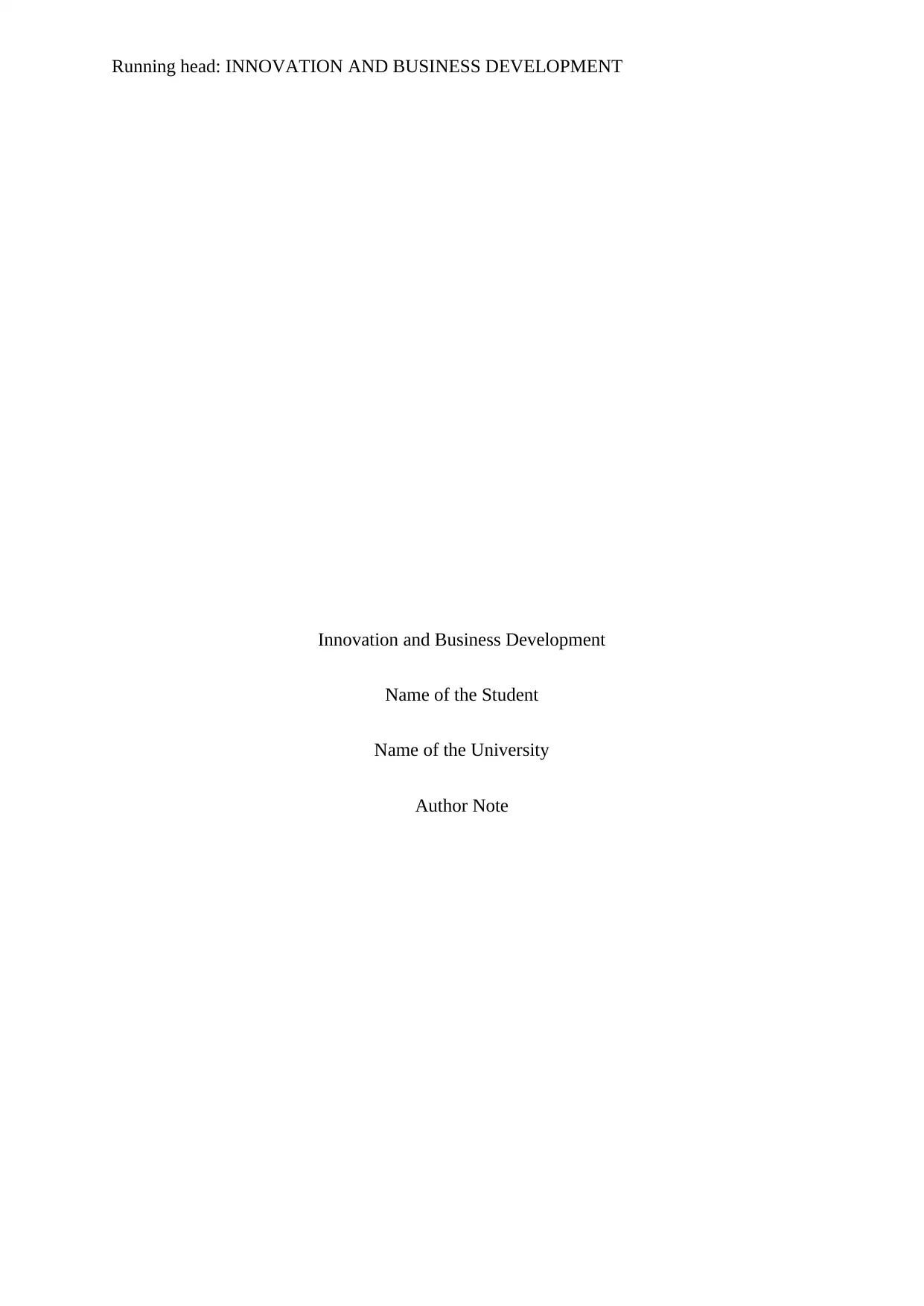
Running head: INNOVATION AND BUSINESS DEVELOPMENT
Innovation and Business Development
Name of the Student
Name of the University
Author Note
Innovation and Business Development
Name of the Student
Name of the University
Author Note
Secure Best Marks with AI Grader
Need help grading? Try our AI Grader for instant feedback on your assignments.
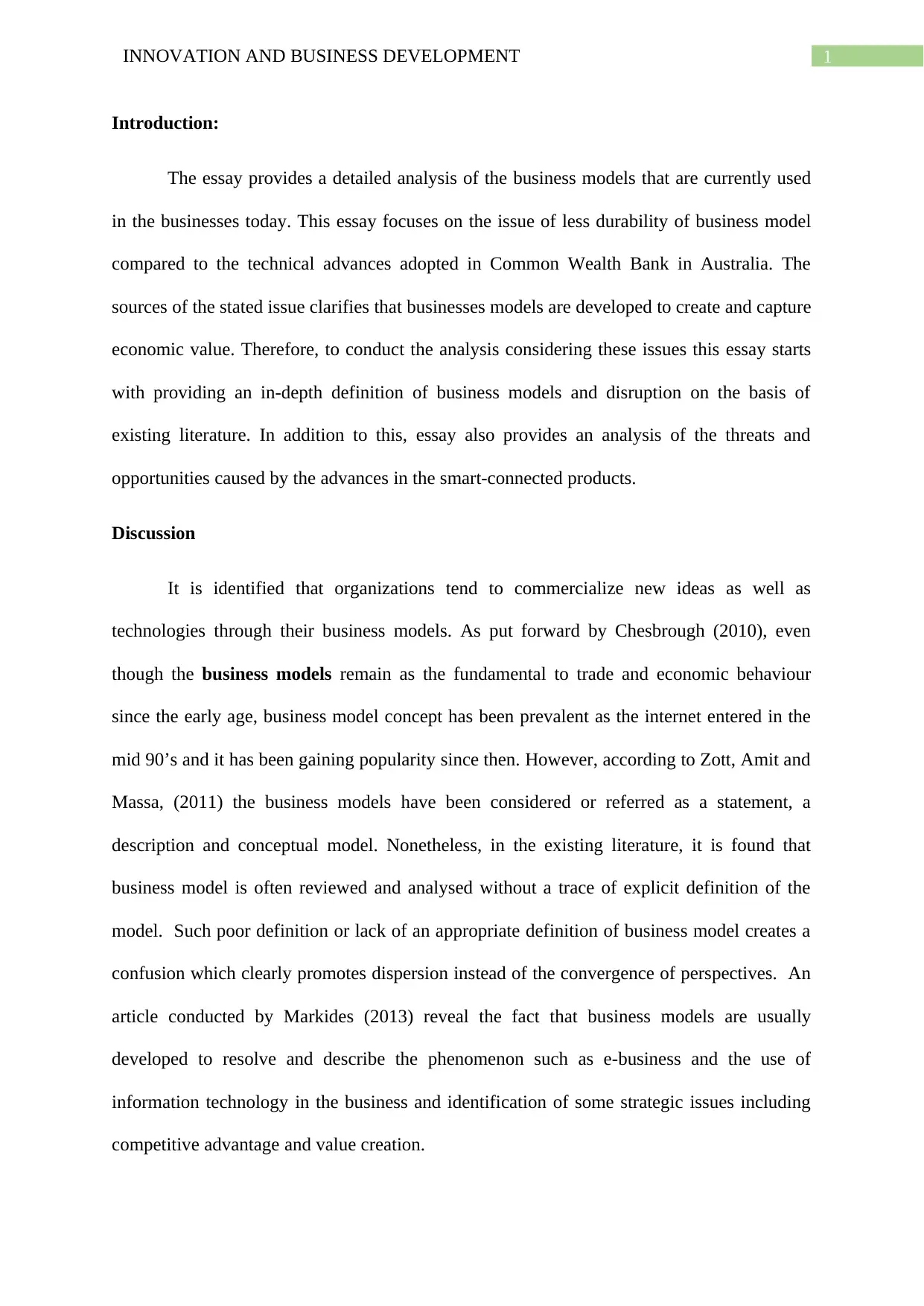
1INNOVATION AND BUSINESS DEVELOPMENT
Introduction:
The essay provides a detailed analysis of the business models that are currently used
in the businesses today. This essay focuses on the issue of less durability of business model
compared to the technical advances adopted in Common Wealth Bank in Australia. The
sources of the stated issue clarifies that businesses models are developed to create and capture
economic value. Therefore, to conduct the analysis considering these issues this essay starts
with providing an in-depth definition of business models and disruption on the basis of
existing literature. In addition to this, essay also provides an analysis of the threats and
opportunities caused by the advances in the smart-connected products.
Discussion
It is identified that organizations tend to commercialize new ideas as well as
technologies through their business models. As put forward by Chesbrough (2010), even
though the business models remain as the fundamental to trade and economic behaviour
since the early age, business model concept has been prevalent as the internet entered in the
mid 90’s and it has been gaining popularity since then. However, according to Zott, Amit and
Massa, (2011) the business models have been considered or referred as a statement, a
description and conceptual model. Nonetheless, in the existing literature, it is found that
business model is often reviewed and analysed without a trace of explicit definition of the
model. Such poor definition or lack of an appropriate definition of business model creates a
confusion which clearly promotes dispersion instead of the convergence of perspectives. An
article conducted by Markides (2013) reveal the fact that business models are usually
developed to resolve and describe the phenomenon such as e-business and the use of
information technology in the business and identification of some strategic issues including
competitive advantage and value creation.
Introduction:
The essay provides a detailed analysis of the business models that are currently used
in the businesses today. This essay focuses on the issue of less durability of business model
compared to the technical advances adopted in Common Wealth Bank in Australia. The
sources of the stated issue clarifies that businesses models are developed to create and capture
economic value. Therefore, to conduct the analysis considering these issues this essay starts
with providing an in-depth definition of business models and disruption on the basis of
existing literature. In addition to this, essay also provides an analysis of the threats and
opportunities caused by the advances in the smart-connected products.
Discussion
It is identified that organizations tend to commercialize new ideas as well as
technologies through their business models. As put forward by Chesbrough (2010), even
though the business models remain as the fundamental to trade and economic behaviour
since the early age, business model concept has been prevalent as the internet entered in the
mid 90’s and it has been gaining popularity since then. However, according to Zott, Amit and
Massa, (2011) the business models have been considered or referred as a statement, a
description and conceptual model. Nonetheless, in the existing literature, it is found that
business model is often reviewed and analysed without a trace of explicit definition of the
model. Such poor definition or lack of an appropriate definition of business model creates a
confusion which clearly promotes dispersion instead of the convergence of perspectives. An
article conducted by Markides (2013) reveal the fact that business models are usually
developed to resolve and describe the phenomenon such as e-business and the use of
information technology in the business and identification of some strategic issues including
competitive advantage and value creation.
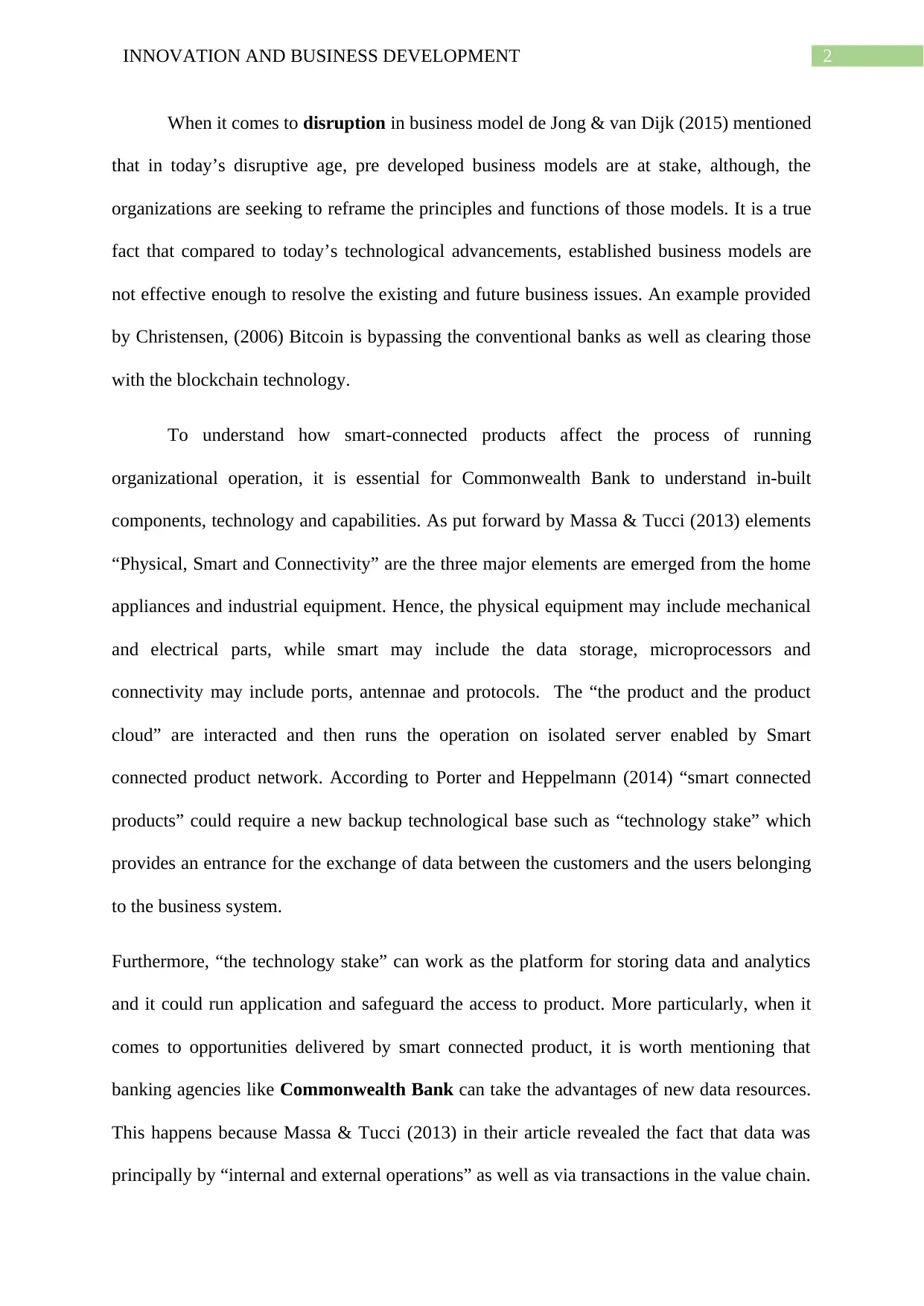
2INNOVATION AND BUSINESS DEVELOPMENT
When it comes to disruption in business model de Jong & van Dijk (2015) mentioned
that in today’s disruptive age, pre developed business models are at stake, although, the
organizations are seeking to reframe the principles and functions of those models. It is a true
fact that compared to today’s technological advancements, established business models are
not effective enough to resolve the existing and future business issues. An example provided
by Christensen, (2006) Bitcoin is bypassing the conventional banks as well as clearing those
with the blockchain technology.
To understand how smart-connected products affect the process of running
organizational operation, it is essential for Commonwealth Bank to understand in-built
components, technology and capabilities. As put forward by Massa & Tucci (2013) elements
“Physical, Smart and Connectivity” are the three major elements are emerged from the home
appliances and industrial equipment. Hence, the physical equipment may include mechanical
and electrical parts, while smart may include the data storage, microprocessors and
connectivity may include ports, antennae and protocols. The “the product and the product
cloud” are interacted and then runs the operation on isolated server enabled by Smart
connected product network. According to Porter and Heppelmann (2014) “smart connected
products” could require a new backup technological base such as “technology stake” which
provides an entrance for the exchange of data between the customers and the users belonging
to the business system.
Furthermore, “the technology stake” can work as the platform for storing data and analytics
and it could run application and safeguard the access to product. More particularly, when it
comes to opportunities delivered by smart connected product, it is worth mentioning that
banking agencies like Commonwealth Bank can take the advantages of new data resources.
This happens because Massa & Tucci (2013) in their article revealed the fact that data was
principally by “internal and external operations” as well as via transactions in the value chain.
When it comes to disruption in business model de Jong & van Dijk (2015) mentioned
that in today’s disruptive age, pre developed business models are at stake, although, the
organizations are seeking to reframe the principles and functions of those models. It is a true
fact that compared to today’s technological advancements, established business models are
not effective enough to resolve the existing and future business issues. An example provided
by Christensen, (2006) Bitcoin is bypassing the conventional banks as well as clearing those
with the blockchain technology.
To understand how smart-connected products affect the process of running
organizational operation, it is essential for Commonwealth Bank to understand in-built
components, technology and capabilities. As put forward by Massa & Tucci (2013) elements
“Physical, Smart and Connectivity” are the three major elements are emerged from the home
appliances and industrial equipment. Hence, the physical equipment may include mechanical
and electrical parts, while smart may include the data storage, microprocessors and
connectivity may include ports, antennae and protocols. The “the product and the product
cloud” are interacted and then runs the operation on isolated server enabled by Smart
connected product network. According to Porter and Heppelmann (2014) “smart connected
products” could require a new backup technological base such as “technology stake” which
provides an entrance for the exchange of data between the customers and the users belonging
to the business system.
Furthermore, “the technology stake” can work as the platform for storing data and analytics
and it could run application and safeguard the access to product. More particularly, when it
comes to opportunities delivered by smart connected product, it is worth mentioning that
banking agencies like Commonwealth Bank can take the advantages of new data resources.
This happens because Massa & Tucci (2013) in their article revealed the fact that data was
principally by “internal and external operations” as well as via transactions in the value chain.
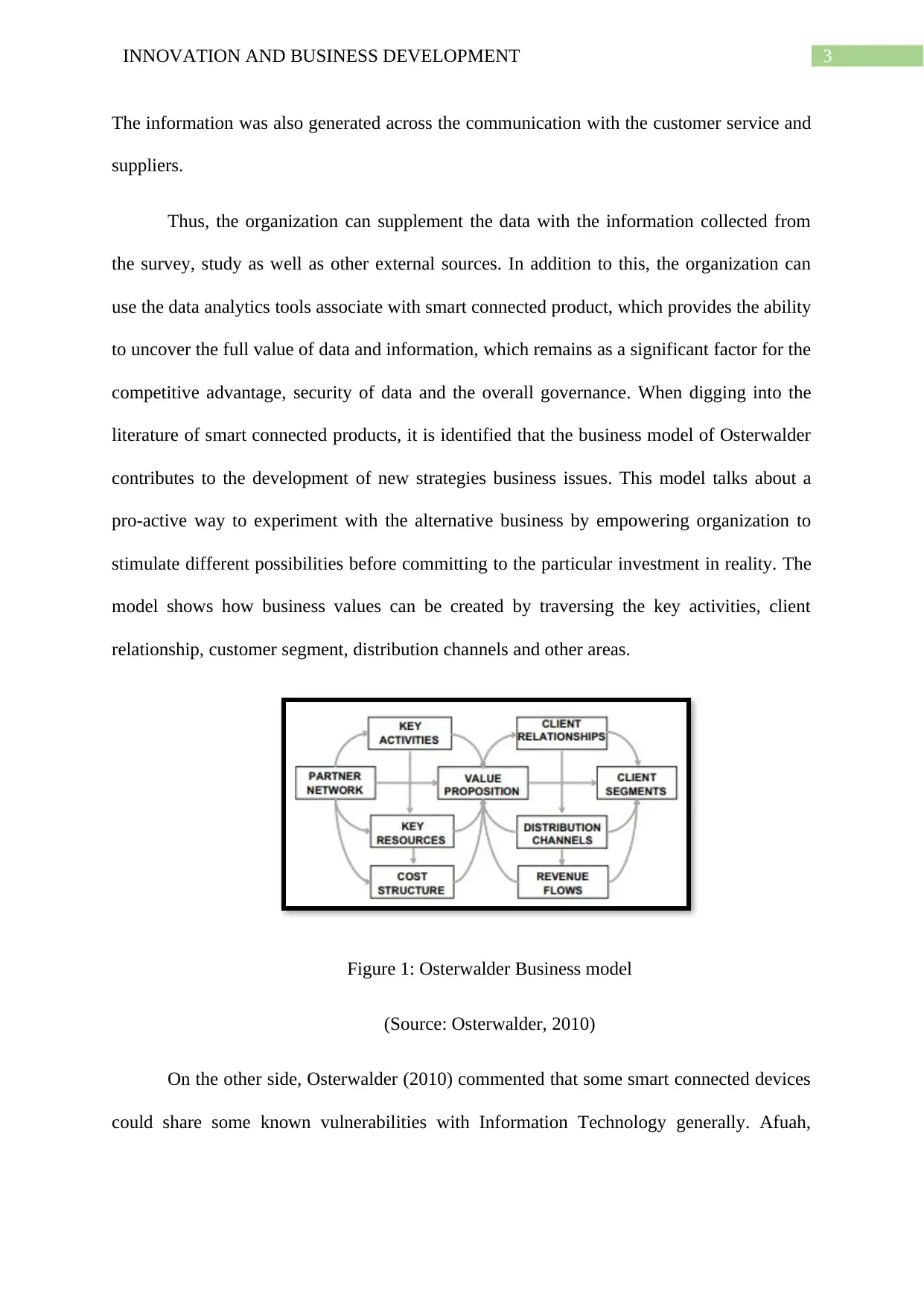
3INNOVATION AND BUSINESS DEVELOPMENT
The information was also generated across the communication with the customer service and
suppliers.
Thus, the organization can supplement the data with the information collected from
the survey, study as well as other external sources. In addition to this, the organization can
use the data analytics tools associate with smart connected product, which provides the ability
to uncover the full value of data and information, which remains as a significant factor for the
competitive advantage, security of data and the overall governance. When digging into the
literature of smart connected products, it is identified that the business model of Osterwalder
contributes to the development of new strategies business issues. This model talks about a
pro-active way to experiment with the alternative business by empowering organization to
stimulate different possibilities before committing to the particular investment in reality. The
model shows how business values can be created by traversing the key activities, client
relationship, customer segment, distribution channels and other areas.
Figure 1: Osterwalder Business model
(Source: Osterwalder, 2010)
On the other side, Osterwalder (2010) commented that some smart connected devices
could share some known vulnerabilities with Information Technology generally. Afuah,
The information was also generated across the communication with the customer service and
suppliers.
Thus, the organization can supplement the data with the information collected from
the survey, study as well as other external sources. In addition to this, the organization can
use the data analytics tools associate with smart connected product, which provides the ability
to uncover the full value of data and information, which remains as a significant factor for the
competitive advantage, security of data and the overall governance. When digging into the
literature of smart connected products, it is identified that the business model of Osterwalder
contributes to the development of new strategies business issues. This model talks about a
pro-active way to experiment with the alternative business by empowering organization to
stimulate different possibilities before committing to the particular investment in reality. The
model shows how business values can be created by traversing the key activities, client
relationship, customer segment, distribution channels and other areas.
Figure 1: Osterwalder Business model
(Source: Osterwalder, 2010)
On the other side, Osterwalder (2010) commented that some smart connected devices
could share some known vulnerabilities with Information Technology generally. Afuah,
Secure Best Marks with AI Grader
Need help grading? Try our AI Grader for instant feedback on your assignments.
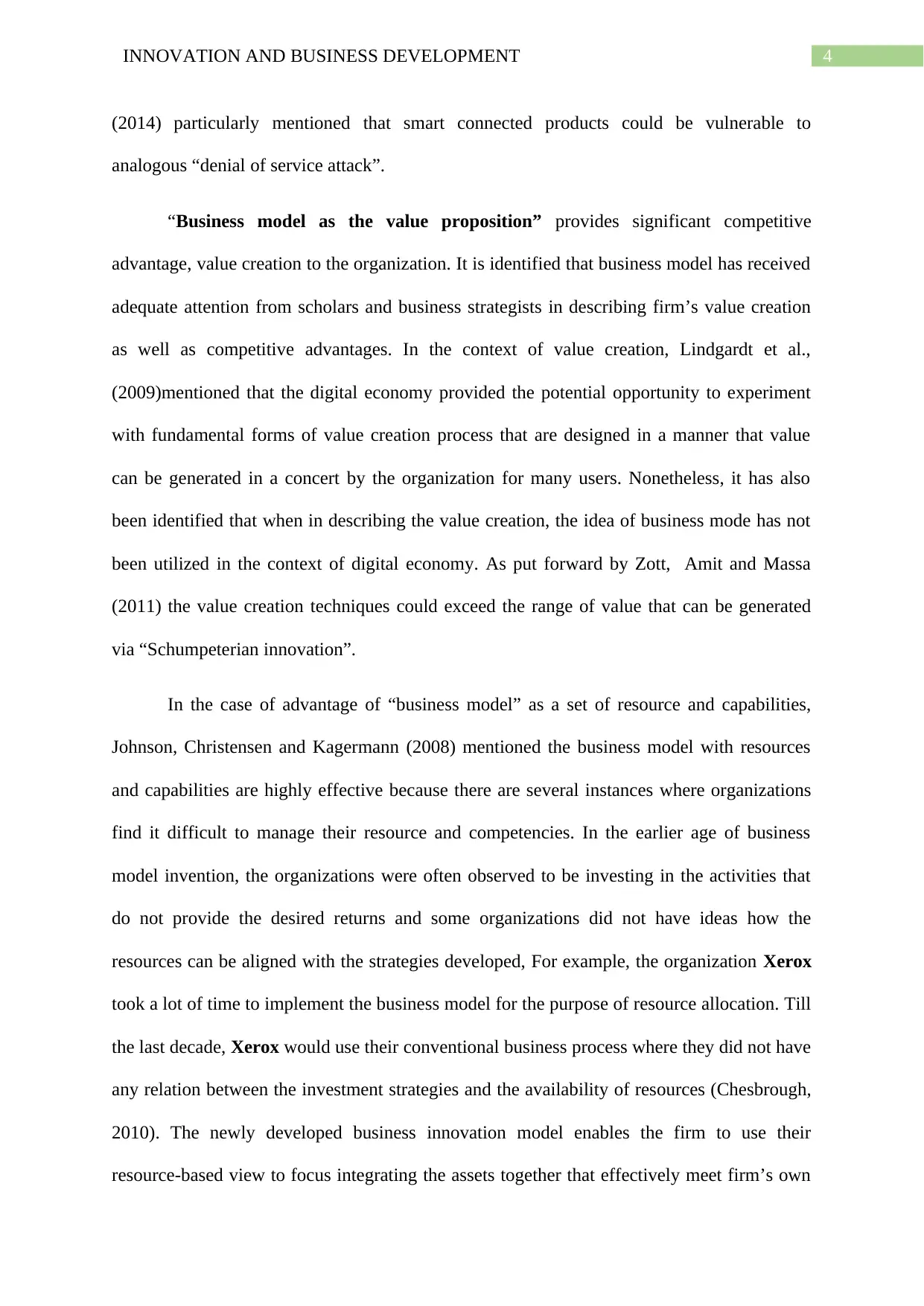
4INNOVATION AND BUSINESS DEVELOPMENT
(2014) particularly mentioned that smart connected products could be vulnerable to
analogous “denial of service attack”.
“Business model as the value proposition” provides significant competitive
advantage, value creation to the organization. It is identified that business model has received
adequate attention from scholars and business strategists in describing firm’s value creation
as well as competitive advantages. In the context of value creation, Lindgardt et al.,
(2009)mentioned that the digital economy provided the potential opportunity to experiment
with fundamental forms of value creation process that are designed in a manner that value
can be generated in a concert by the organization for many users. Nonetheless, it has also
been identified that when in describing the value creation, the idea of business mode has not
been utilized in the context of digital economy. As put forward by Zott, Amit and Massa
(2011) the value creation techniques could exceed the range of value that can be generated
via “Schumpeterian innovation”.
In the case of advantage of “business model” as a set of resource and capabilities,
Johnson, Christensen and Kagermann (2008) mentioned the business model with resources
and capabilities are highly effective because there are several instances where organizations
find it difficult to manage their resource and competencies. In the earlier age of business
model invention, the organizations were often observed to be investing in the activities that
do not provide the desired returns and some organizations did not have ideas how the
resources can be aligned with the strategies developed, For example, the organization Xerox
took a lot of time to implement the business model for the purpose of resource allocation. Till
the last decade, Xerox would use their conventional business process where they did not have
any relation between the investment strategies and the availability of resources (Chesbrough,
2010). The newly developed business innovation model enables the firm to use their
resource-based view to focus integrating the assets together that effectively meet firm’s own
(2014) particularly mentioned that smart connected products could be vulnerable to
analogous “denial of service attack”.
“Business model as the value proposition” provides significant competitive
advantage, value creation to the organization. It is identified that business model has received
adequate attention from scholars and business strategists in describing firm’s value creation
as well as competitive advantages. In the context of value creation, Lindgardt et al.,
(2009)mentioned that the digital economy provided the potential opportunity to experiment
with fundamental forms of value creation process that are designed in a manner that value
can be generated in a concert by the organization for many users. Nonetheless, it has also
been identified that when in describing the value creation, the idea of business mode has not
been utilized in the context of digital economy. As put forward by Zott, Amit and Massa
(2011) the value creation techniques could exceed the range of value that can be generated
via “Schumpeterian innovation”.
In the case of advantage of “business model” as a set of resource and capabilities,
Johnson, Christensen and Kagermann (2008) mentioned the business model with resources
and capabilities are highly effective because there are several instances where organizations
find it difficult to manage their resource and competencies. In the earlier age of business
model invention, the organizations were often observed to be investing in the activities that
do not provide the desired returns and some organizations did not have ideas how the
resources can be aligned with the strategies developed, For example, the organization Xerox
took a lot of time to implement the business model for the purpose of resource allocation. Till
the last decade, Xerox would use their conventional business process where they did not have
any relation between the investment strategies and the availability of resources (Chesbrough,
2010). The newly developed business innovation model enables the firm to use their
resource-based view to focus integrating the assets together that effectively meet firm’s own
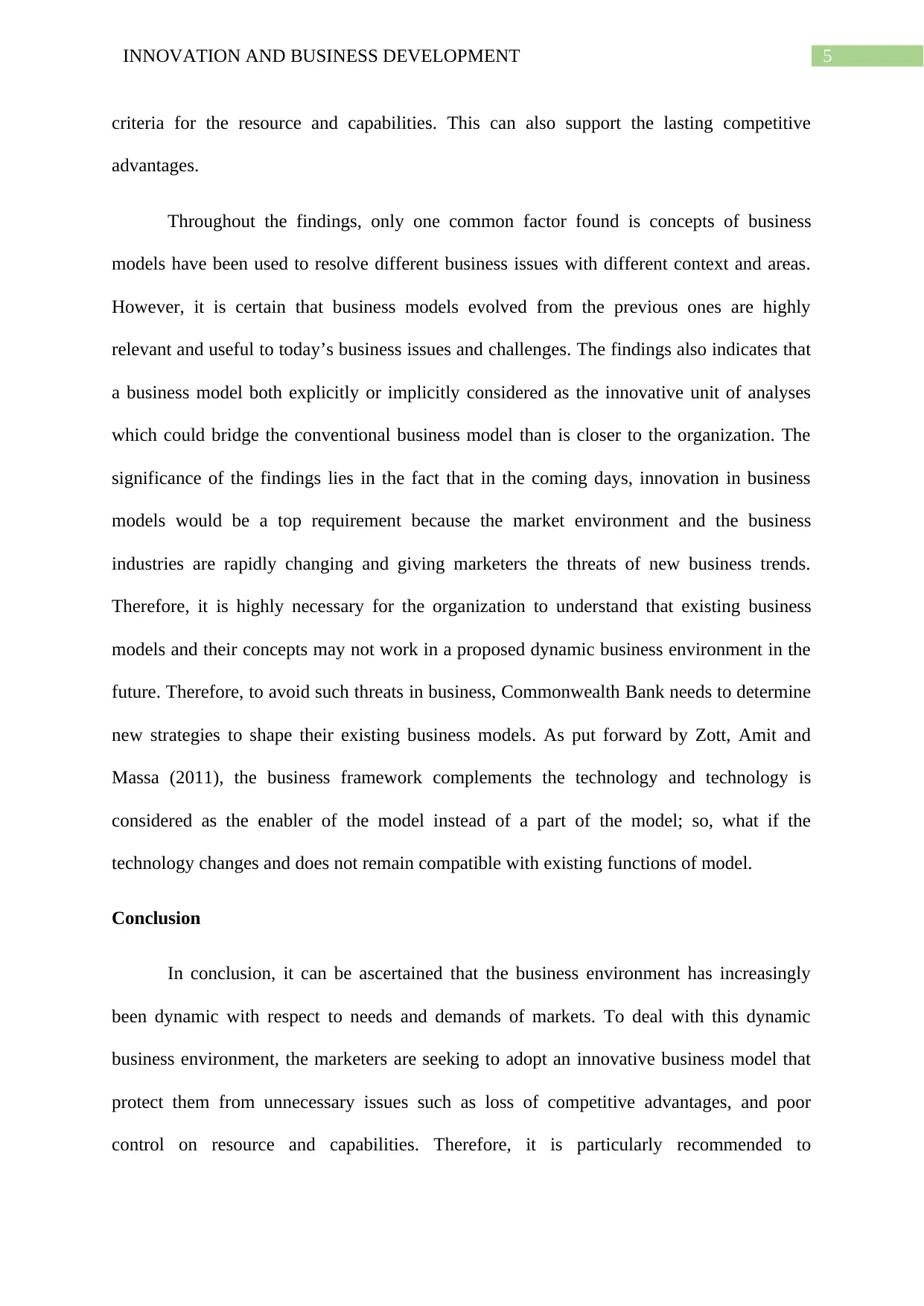
5INNOVATION AND BUSINESS DEVELOPMENT
criteria for the resource and capabilities. This can also support the lasting competitive
advantages.
Throughout the findings, only one common factor found is concepts of business
models have been used to resolve different business issues with different context and areas.
However, it is certain that business models evolved from the previous ones are highly
relevant and useful to today’s business issues and challenges. The findings also indicates that
a business model both explicitly or implicitly considered as the innovative unit of analyses
which could bridge the conventional business model than is closer to the organization. The
significance of the findings lies in the fact that in the coming days, innovation in business
models would be a top requirement because the market environment and the business
industries are rapidly changing and giving marketers the threats of new business trends.
Therefore, it is highly necessary for the organization to understand that existing business
models and their concepts may not work in a proposed dynamic business environment in the
future. Therefore, to avoid such threats in business, Commonwealth Bank needs to determine
new strategies to shape their existing business models. As put forward by Zott, Amit and
Massa (2011), the business framework complements the technology and technology is
considered as the enabler of the model instead of a part of the model; so, what if the
technology changes and does not remain compatible with existing functions of model.
Conclusion
In conclusion, it can be ascertained that the business environment has increasingly
been dynamic with respect to needs and demands of markets. To deal with this dynamic
business environment, the marketers are seeking to adopt an innovative business model that
protect them from unnecessary issues such as loss of competitive advantages, and poor
control on resource and capabilities. Therefore, it is particularly recommended to
criteria for the resource and capabilities. This can also support the lasting competitive
advantages.
Throughout the findings, only one common factor found is concepts of business
models have been used to resolve different business issues with different context and areas.
However, it is certain that business models evolved from the previous ones are highly
relevant and useful to today’s business issues and challenges. The findings also indicates that
a business model both explicitly or implicitly considered as the innovative unit of analyses
which could bridge the conventional business model than is closer to the organization. The
significance of the findings lies in the fact that in the coming days, innovation in business
models would be a top requirement because the market environment and the business
industries are rapidly changing and giving marketers the threats of new business trends.
Therefore, it is highly necessary for the organization to understand that existing business
models and their concepts may not work in a proposed dynamic business environment in the
future. Therefore, to avoid such threats in business, Commonwealth Bank needs to determine
new strategies to shape their existing business models. As put forward by Zott, Amit and
Massa (2011), the business framework complements the technology and technology is
considered as the enabler of the model instead of a part of the model; so, what if the
technology changes and does not remain compatible with existing functions of model.
Conclusion
In conclusion, it can be ascertained that the business environment has increasingly
been dynamic with respect to needs and demands of markets. To deal with this dynamic
business environment, the marketers are seeking to adopt an innovative business model that
protect them from unnecessary issues such as loss of competitive advantages, and poor
control on resource and capabilities. Therefore, it is particularly recommended to
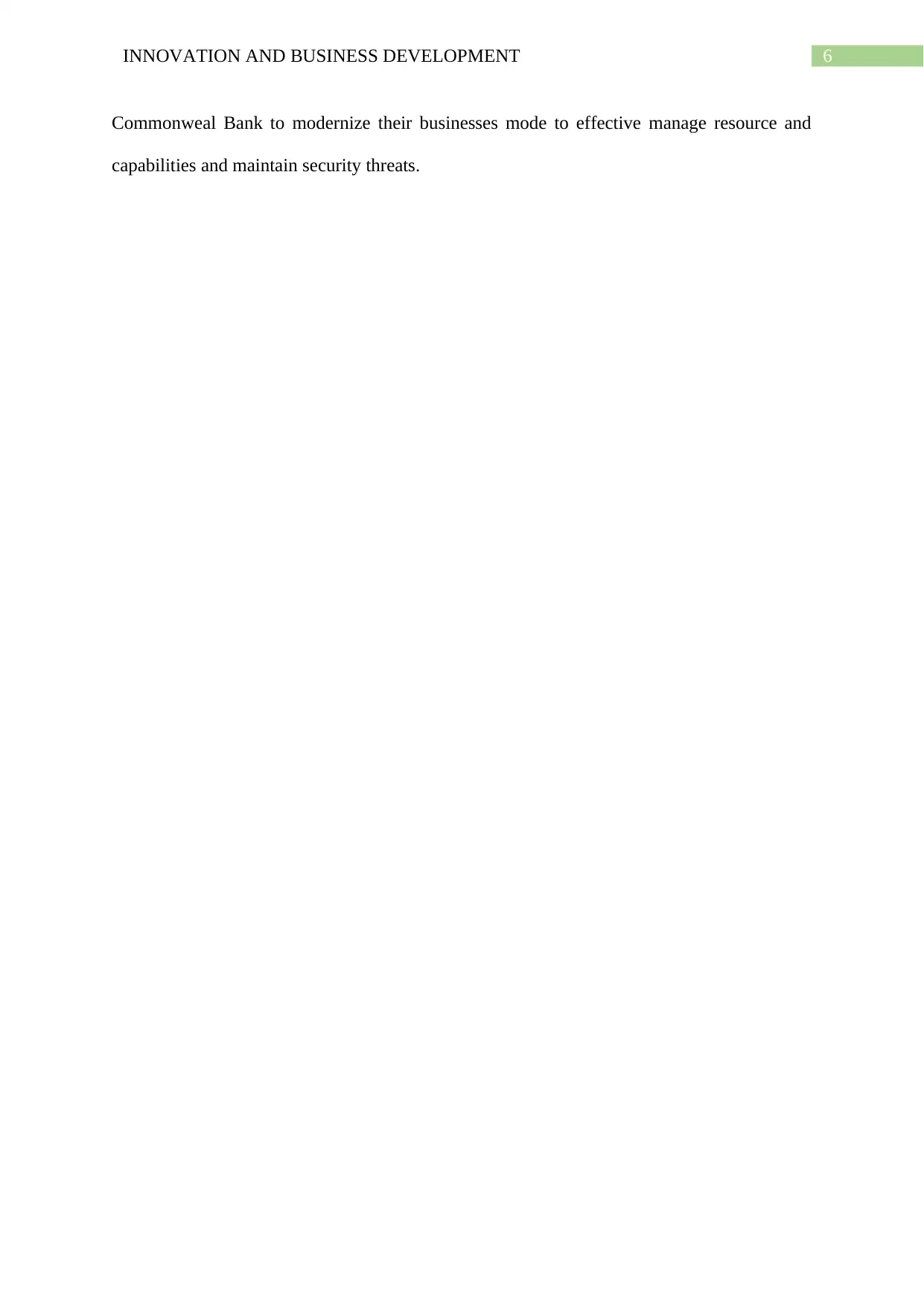
6INNOVATION AND BUSINESS DEVELOPMENT
Commonweal Bank to modernize their businesses mode to effective manage resource and
capabilities and maintain security threats.
Commonweal Bank to modernize their businesses mode to effective manage resource and
capabilities and maintain security threats.
Paraphrase This Document
Need a fresh take? Get an instant paraphrase of this document with our AI Paraphraser
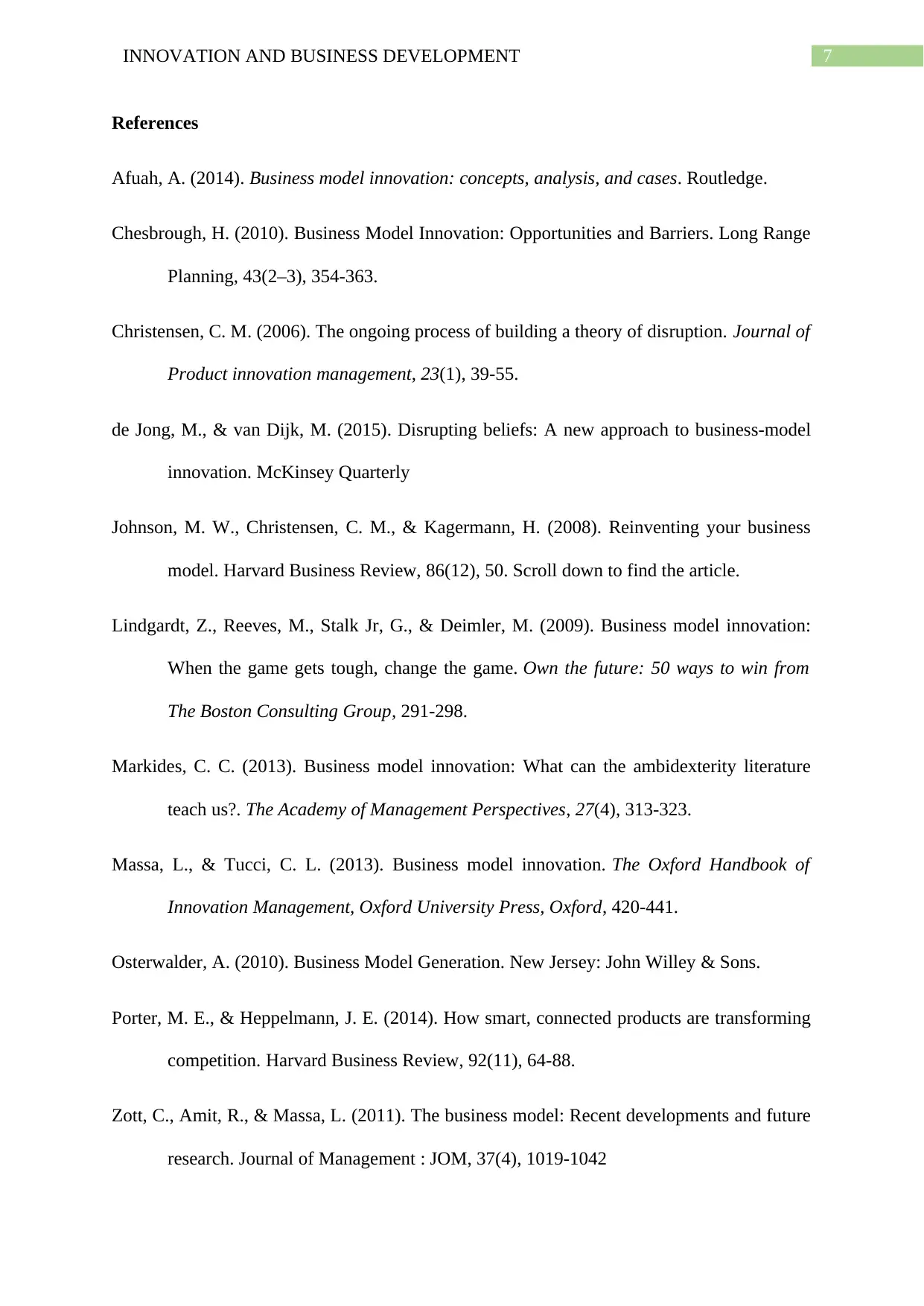
7INNOVATION AND BUSINESS DEVELOPMENT
References
Afuah, A. (2014). Business model innovation: concepts, analysis, and cases. Routledge.
Chesbrough, H. (2010). Business Model Innovation: Opportunities and Barriers. Long Range
Planning, 43(2–3), 354-363.
Christensen, C. M. (2006). The ongoing process of building a theory of disruption. Journal of
Product innovation management, 23(1), 39-55.
de Jong, M., & van Dijk, M. (2015). Disrupting beliefs: A new approach to business-model
innovation. McKinsey Quarterly
Johnson, M. W., Christensen, C. M., & Kagermann, H. (2008). Reinventing your business
model. Harvard Business Review, 86(12), 50. Scroll down to find the article.
Lindgardt, Z., Reeves, M., Stalk Jr, G., & Deimler, M. (2009). Business model innovation:
When the game gets tough, change the game. Own the future: 50 ways to win from
The Boston Consulting Group, 291-298.
Markides, C. C. (2013). Business model innovation: What can the ambidexterity literature
teach us?. The Academy of Management Perspectives, 27(4), 313-323.
Massa, L., & Tucci, C. L. (2013). Business model innovation. The Oxford Handbook of
Innovation Management, Oxford University Press, Oxford, 420-441.
Osterwalder, A. (2010). Business Model Generation. New Jersey: John Willey & Sons.
Porter, M. E., & Heppelmann, J. E. (2014). How smart, connected products are transforming
competition. Harvard Business Review, 92(11), 64-88.
Zott, C., Amit, R., & Massa, L. (2011). The business model: Recent developments and future
research. Journal of Management : JOM, 37(4), 1019-1042
References
Afuah, A. (2014). Business model innovation: concepts, analysis, and cases. Routledge.
Chesbrough, H. (2010). Business Model Innovation: Opportunities and Barriers. Long Range
Planning, 43(2–3), 354-363.
Christensen, C. M. (2006). The ongoing process of building a theory of disruption. Journal of
Product innovation management, 23(1), 39-55.
de Jong, M., & van Dijk, M. (2015). Disrupting beliefs: A new approach to business-model
innovation. McKinsey Quarterly
Johnson, M. W., Christensen, C. M., & Kagermann, H. (2008). Reinventing your business
model. Harvard Business Review, 86(12), 50. Scroll down to find the article.
Lindgardt, Z., Reeves, M., Stalk Jr, G., & Deimler, M. (2009). Business model innovation:
When the game gets tough, change the game. Own the future: 50 ways to win from
The Boston Consulting Group, 291-298.
Markides, C. C. (2013). Business model innovation: What can the ambidexterity literature
teach us?. The Academy of Management Perspectives, 27(4), 313-323.
Massa, L., & Tucci, C. L. (2013). Business model innovation. The Oxford Handbook of
Innovation Management, Oxford University Press, Oxford, 420-441.
Osterwalder, A. (2010). Business Model Generation. New Jersey: John Willey & Sons.
Porter, M. E., & Heppelmann, J. E. (2014). How smart, connected products are transforming
competition. Harvard Business Review, 92(11), 64-88.
Zott, C., Amit, R., & Massa, L. (2011). The business model: Recent developments and future
research. Journal of Management : JOM, 37(4), 1019-1042

8INNOVATION AND BUSINESS DEVELOPMENT
1 out of 9
Related Documents
Your All-in-One AI-Powered Toolkit for Academic Success.
+13062052269
info@desklib.com
Available 24*7 on WhatsApp / Email
![[object Object]](/_next/static/media/star-bottom.7253800d.svg)
Unlock your academic potential
© 2024 | Zucol Services PVT LTD | All rights reserved.




